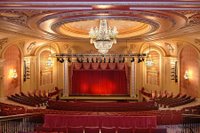"The Lonely One" is a shadowy figure in Bradbury's novel
Dandelion Wine. A serial killer who haunts the Ravine by night, and suffuses Green Town with an unwelcome air of fear and death. He is brought most vividly to life in the chapter about Lavinia Nebbs, which has also frequently been reprinted as a self-contained short story called "The Whole Town's Sleeping":
And Death was the Lonely One, unseen, walking and standing behind trees, waiting in the country to come in, once or twice a year, to this town, to these streets, to these many places where there was little light, to kill one, two, three women in the past three years. That was Death...
Ray Bradbury, Dandelion Wine
Bradbury has never disguised the fact that his Lonely One is a fanciful extrapolation of a real criminal who held Waukegan, Illinois, in his grip:
Was there a Lonely One?
There was, and that was his name. And he moved around at night in my home town when I was six years old and he frightened everyone and was never captured.
Ray Bradbury, "Just This Size of Byzantium", introduction to Dandelion Wine
In some discussions, Bradbury has clarified further, and reported that the real Lonely One was a kind of cat burglar. This is the version of events recounted (albeit briefly) in Bradbury's official biography:
The identity of the real-life Lonely One would never come to light. The cat burglar was never captured.
Sam Weller, The Bradbury Chronicles
Actually, Weller is incorrect. The real Lonely One
was identified
and captured. His name was
Orvel Weyant, and he was captured in 1928. He spent at least a year behind bars.
And he looked like this:
 Orvel Weyant, image from Chicago Tribune, 18 Oct 1928
Orvel Weyant, image from Chicago Tribune, 18 Oct 1928
The real Lonely One's modus operandi was rather odd. According to the Chicago Tribune (2 August 1928, page 11), he would break into a gas station or a store and leave a note for the police, after helping himself to cash or goods. After months of such break-ins he became irritated at the lack of press coverage of his bad deeds, and wrote a letter of complaint to a local newspaper.
Eight months after he started his crime spree, Weyant was captured. He was spotted breaking into the Frank Burke Hardware Store in Waukegan, where he swapped his gun for a shiny new pistol.
The police cornered him. Weyant threatened to shoot himself, unless the police promised not to mistreat him upon his arrest. He was taken into custody in October 1928 (Chicago Tribune, 18 October 1928, page 16).
After his arrest, the previously unreported aspects of Weyant's crimes finally appeared in the press. Starting on 1 February 1928, he had broken into 33 places of business. Each time he broke in somewhere, he would write three letters. One was left for the owner of the premises, expressing his sympathy for their losses. A second was sent to the press, telling them how he did it. A third letter went to the police - telling them that they needed practice in solving crime. All letters were signed: "The Lonely One".
After just over a year in jail, Weyant was considered for parole. At this time, the Chicago Tribune (30 January 1930) reported that Weyant had stolen about $100 worth of goods from his burglaries, but was actually poorer after his spree than he had been to begin with. Police Chief Tom Kennedy suggested that Weyant was far from a master criminal, but was not averse to violence. He took potshots at the police on more than one occasion, although he didn't do this on the night of his arrest...but only because he picked up the wrong calibre of bullets to go with that shiny new pistol.
Weyant's parole was denied, and he continued serving a jail term of "one year to life".
It's not clear what happened to him after this point, but on 17 April 1974 the Waukegan News-Sun carried an article by one Arne Christensen, who claimed to have been at school with Weyant. Christensen contrasted the Weyant he had known ("a friendly, outsize, unmotivated sixth grader with a colossal contempt for anything smacking of book learning") with his recollection of the press coverage of The Lonely One ("...antics catapulted him into the role of a folk hero...the public found humor in the ineptness of the police in failing to foil him.")
Christensen's article ends with him asking if anyone knows what became of Orvel.
While some of the news reports name him "Orville Weyant" or "Orville Wyant", he is more often named as "Orvel Weyant". Beyond this, all we know is that he was born circa 1910, and that before his arrest he worked as a stoker for the E.J. & E "railroad roundhouse".
"Orvel Weyant" is quite a rare name. Google pulls up very few links. One of those few points to a reference to a 1920 Federal Census, showing Orvel (or Orville) as living in Lake County, Illinois, and with a birth date of circa 1910. Waukegan is in Lake County.
The other Google link points to a gravesite record in Honolulu: Orvel Weyant, 3 December 1909 - 6 November 1986.
I can't swear that this is the grave of The Lonely One, but it sounds a pretty good match. I wonder if he ever knew that he had been immortalised in Dandelion Wine?
If it were me, I'd have it etched on my gravestone.
(I am indebted to Beverly Millard of the Waukegan Historical Society for unearthing the newspaper clippings relating to the real Lonely One.)
UPDATE: In October 2021, I produced a podcast episode about "The Lonely One". Find it here: https://bradburymedia.blogspot.com/2021/10/new-bradbury-100-episode-revealed-at.html
---------------------------------------------
Please subscribe to my Bradbury 100 podcast - it's totally free on all platforms. Where to find it:
Main platforms:
Other platforms:











